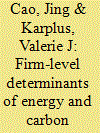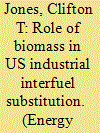| Srl | Item |
| 1 |
ID:
136227


|
|
|
|
|
| Summary/Abstract |
In recent years, China׳s leaders have sought to coordinate official energy intensity reduction targets with new targets for carbon dioxide (CO2) intensity reduction. The Eleventh Five-Year Plan (2006–2010) included for the first time a binding target for energy intensity, while a binding target for CO2 intensity was included later in the Twelfth Five-Year Plan (2011–2015). Using panel data for a sample of industrial firms in China covering 2005 to 2009, we investigate the drivers of energy intensity reduction (measured in terms of direct primary energy use and electricity use) and associated CO2 intensity reduction. Rising electricity prices were associated with decreases in electricity intensity and increases in primary energy intensity, consistent with a substitution effect. Overall, we find that energy intensity reduction by industrial firms during the Eleventh Five-Year Plan translated into more than proportional CO2 intensity reduction because reducing coal use—in direct industrial use as well as in the power sector—was a dominant abatement strategy. If similar dynamics characterize the Twelfth Five-Year Plan (2011–2015), the national 17 percent CO2 intensity reduction target may not be difficult to meet—and the 16 percent energy intensity reduction target may result in significantly greater CO2 intensity reduction.
|
|
|
|
|
|
|
|
|
|
|
|
|
|
|
|
| 2 |
ID:
104813


|
|
|
| 3 |
ID:
132648


|
|
|
|
|
| Publication |
2014.
|
| Summary/Abstract |
The role of biomass in US industrial interfuel substitution in the industrial sector has typically been analyzed using data for the four traditional fuels of coal, oil, electricity and natural gas. However, the use of biomass as an industrial fuel in the US has grown, and now exceeds that of coal. Using data from 1960 to 2011, interfuel substitution in the US industrial sector is modeled with a dynamic linear logit model which includes biomass alongside the other four traditional fuels. Adding biomass to the model reduces somewhat the estimated own-price and cross-price elasticities for the other four fuels, while revealing that biomass and natural gas are substitute fuels. This implies that previous studies excluding biomass may have overestimated the potential for interfuel substitution, giving policy makers an inaccurate impression of the ability of carbon taxes or other environmental regulation to reduce greenhouse gas (GHG) emissions.
|
|
|
|
|
|
|
|
|
|
|
|
|
|
|
|